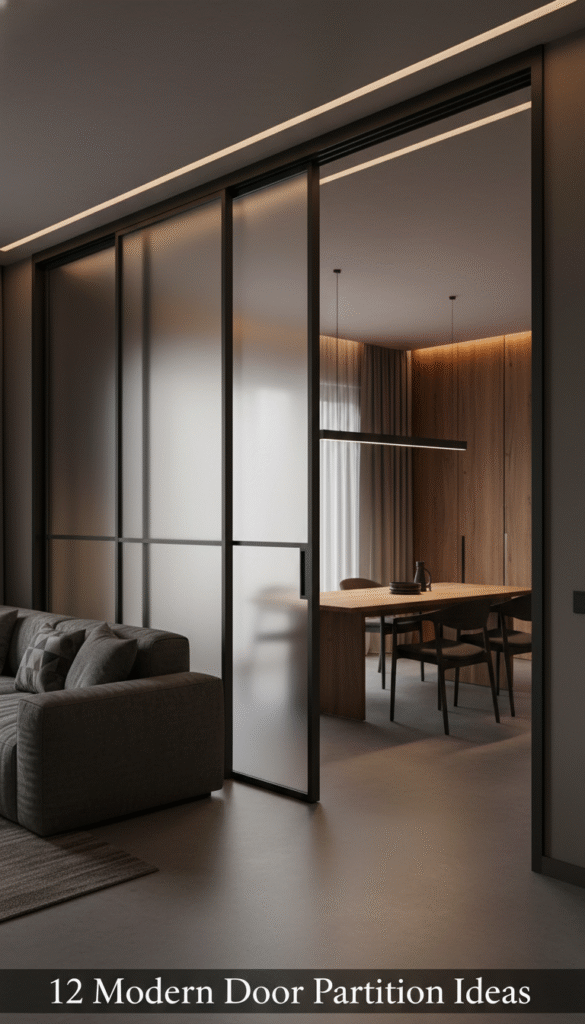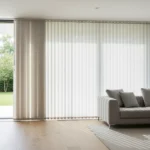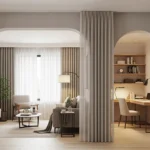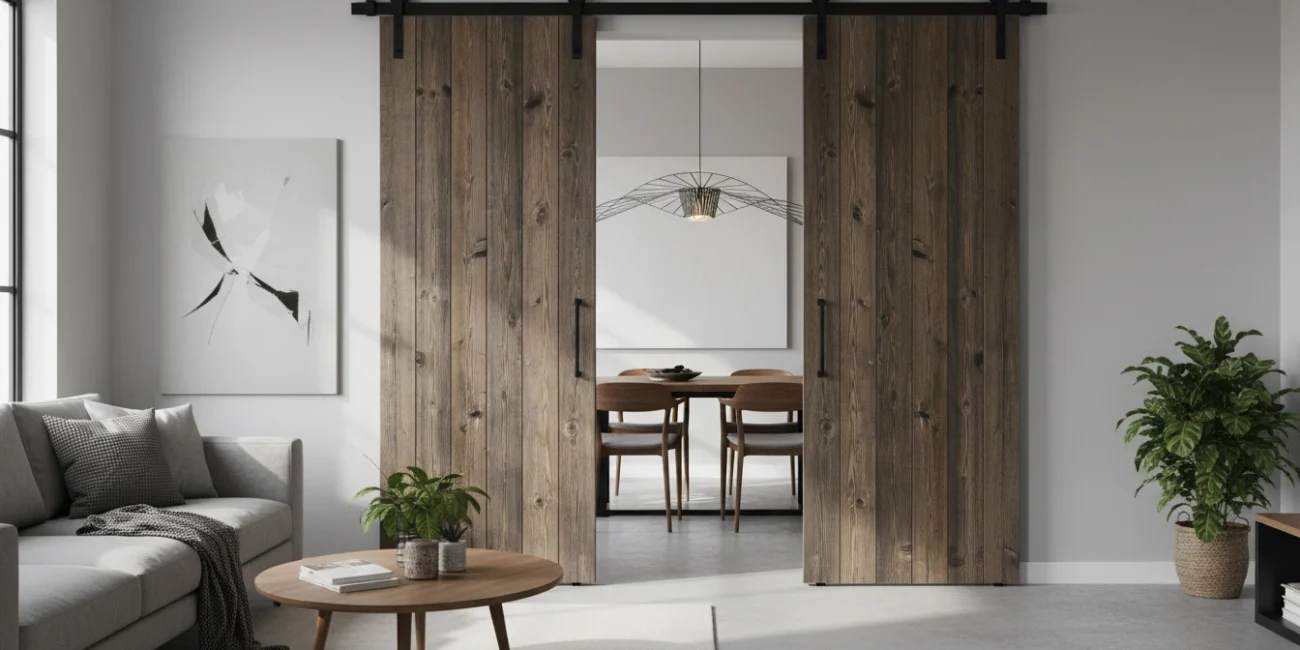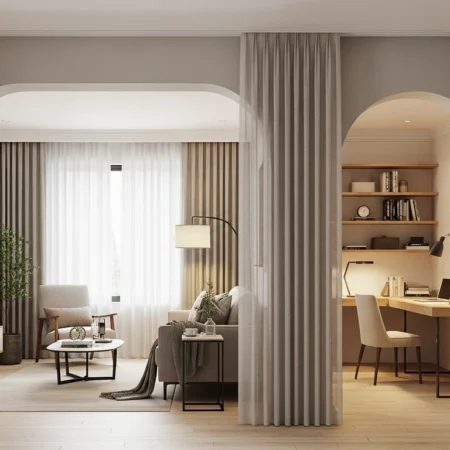If your living room feels like it’s trying to be everything at once—lounging area, dining space, office, and sometimes a temporary storage zone—you’re not alone. Open-plan layouts are beautiful, but they don’t always make day-to-day life easier. Sometimes you just need a little separation without building a wall or blocking out all that lovely light.
That’s exactly where modern door partitions shine. They create structure without heaviness, privacy without isolation, and style without sacrificing space. I’ve always loved how a single door system can completely change the mood of a room—shift it from busy to calm, from scattered to intentional.
Maybe you want to carve out a quiet reading nook, maybe you need a smarter connection between the living room and dining area, or maybe you just enjoy the look of beautifully framed glass catching the afternoon sun. Whatever the reason, a well-chosen partition can make your living room feel more polished and more “you.”
Below, you’ll find twelve modern door partition ideas that bring real function and real personality to a living space. Some are bold, some are subtle, but all of them help your living room work a little harder—and look a little better doing it.
1. Frameless Sliding Glass Doors

Frameless sliding glass doors bring a calm, uninterrupted flow to your living room. They open up the space, invite natural light from every direction, and make even a modest room feel expansive. I’ve always loved how they almost trick your eye into thinking there’s no partition at all—just pure, open space.
Why it works:
• The clean lines keep the room feeling modern and uncluttered.
• Natural light travels freely, which instantly makes the space look bigger.
• The minimalist style pairs with almost any interior design—warm woods, cool metals, soft neutrals, you name it.
• The door tracks can stay discreet, so the entire setup feels seamless.
• They’re ideal when you want a partition that doesn’t visually “cut” the room in half.
2. Black-Framed Industrial Glass Partitions
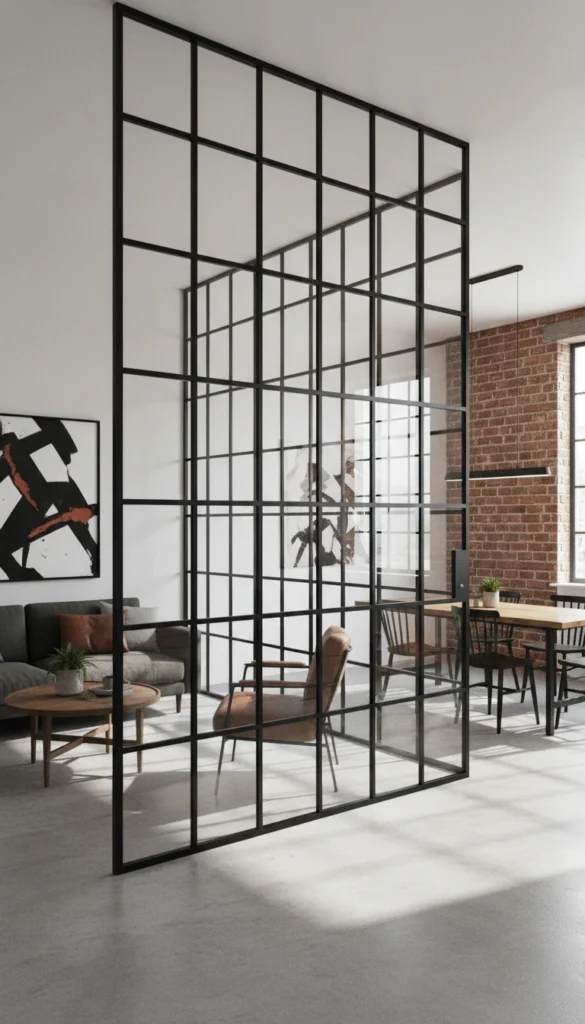
Black-framed glass partitions add instant character to a living room. Their bold grid lines create a rhythm that feels modern and architectural, almost like adding a piece of functional art. If you’ve ever looked at your open-plan layout and wished for more structure without losing brightness, this style steps in beautifully.
What makes it special:
• The metal frames create strong visual definition without feeling heavy.
• The grid pattern introduces texture and graphic interest.
• It pairs naturally with brick, concrete, or wood accents.
• Light still moves freely from room to room, which keeps everything open.
• It’s a great choice if you like a subtle loft-inspired vibe without going full industrial.
3. Soft Ribbed or Fluted Glass Doors

Fluted glass doors add a gentle texture that instantly elevates a living room. They blur shapes just enough to offer privacy while still letting light drift through in that beautifully diffused way. I always think of fluted glass as the design equivalent of soft focus in a movie—it hides the mess but keeps the glow.
Why it works:
• The vertical lines elongate the room and make the ceiling feel taller.
• It softens harsh light and reduces visual noise.
• You get privacy without losing brightness or openness.
• The subtle texture adds sophistication without overwhelming the space.
• It blends easily with minimalist, Japandi, and modern interiors.
4. Sliding Barn-Style Doors with a Modern Twist
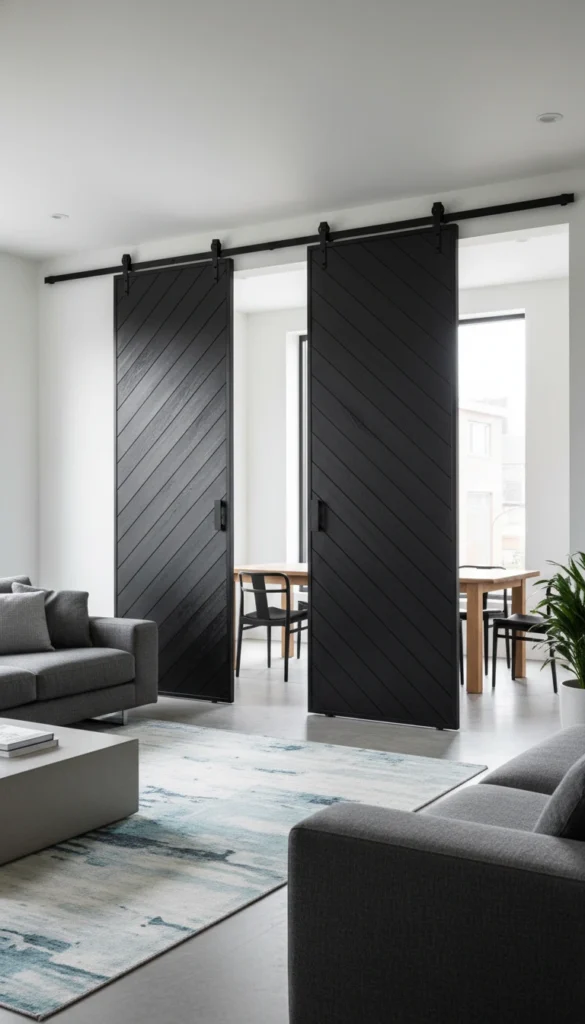
Modern barn doors bring personality to a living room without leaning into rustic clichés. These sleek panels slide effortlessly along the wall, creating a partition that feels intentional and stylish rather than bulky. I love how updated versions—like the matte black ones here—add drama without overwhelming the space.
How to use them:
Lean into contrast—dark doors against light walls always make a statement.
Choose streamlined hardware to keep the look clean.
Use a solid color or smooth finish instead of distressed wood.
Pair them with simple furniture so the doors stay the star.
Keep wall space clear so the doors can slide fully open.
5. Slim Timber Slat Partitions with Integrated Doors

A vertical timber slat partition instantly warms up a modern living room, and hiding a door inside it adds a touch of quiet luxury. The uniform lines draw your eye upward, creating that tall, tailored look you usually see in boutique hotels. I love how the door becomes almost a secret passage—functional, but charmingly subtle.
Why it works:
• The wood texture adds natural warmth and softness.
• Hidden doors keep the visual flow clean and uninterrupted.
• Vertical slats make low ceilings feel taller.
• Light and air can still pass through slatted sections when used more openly.
• It blends beautifully with minimalist, Scandinavian, and Japandi interiors.
6. Pivot Doors as Sculptural Room Dividers
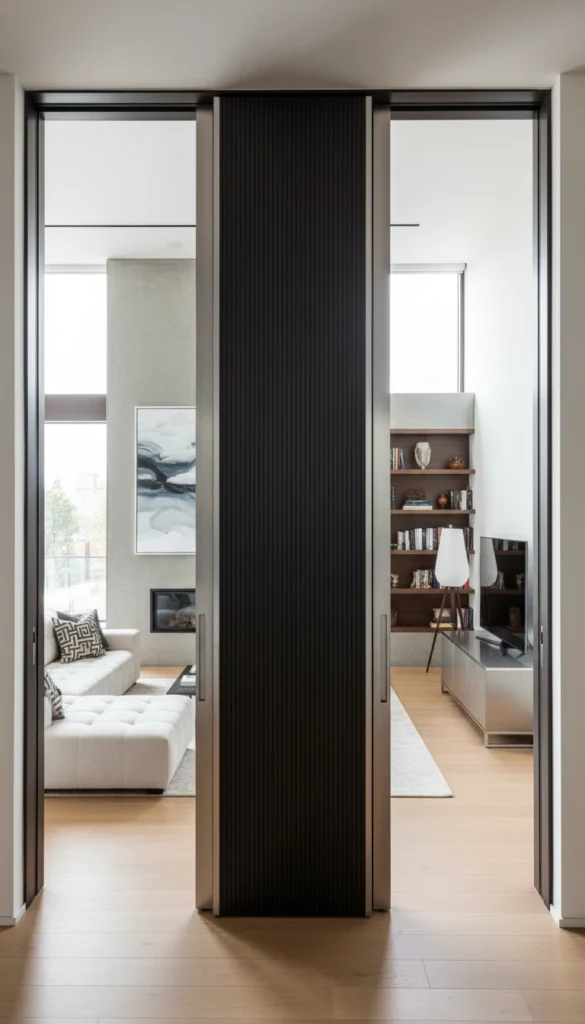
Pivot doors feel less like doors and more like architectural features that happen to move. Their smooth rotation turns a simple partition into a moment—almost like the room takes a breath as the panel swings open. When you use oversized pivot doors in a living room, they divide spaces with real presence and a touch of drama.
Why it matters:
• Pivoting creates a wider, more inviting motion than standard hinges.
• Large panels act as sculptural elements even when closed.
• You can partially open them to fine-tune the openness of the space.
• They pair beautifully with high ceilings and modern layouts.
• The design works equally well in single or double configurations.
7. Minimal Framed Aluminum or Steel Sliding Systems
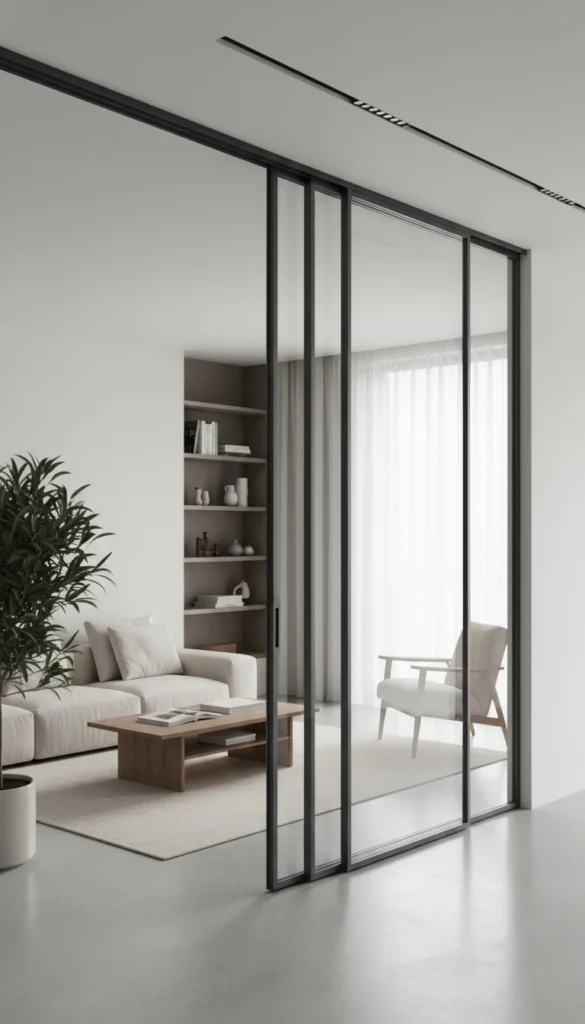
Minimal framed sliding doors have a quiet confidence that suits almost any modern living room. The slim aluminum lines create just enough definition without interrupting the openness of the space. I’ve always appreciated how these systems feel both light and structured—like they’re doing a lot of work without showing off about it.
Key benefits:
• The narrow frames keep sightlines clear and the room airy.
• They allow wide openings without bulky support structures.
• You can choose clear, tinted, or frosted glass depending on privacy needs.
• The understated hardware blends into the architecture instead of distracting from it.
• They work beautifully in minimalist, Scandinavian, and contemporary homes.
8. Folding or Bi-Fold Door Partitions
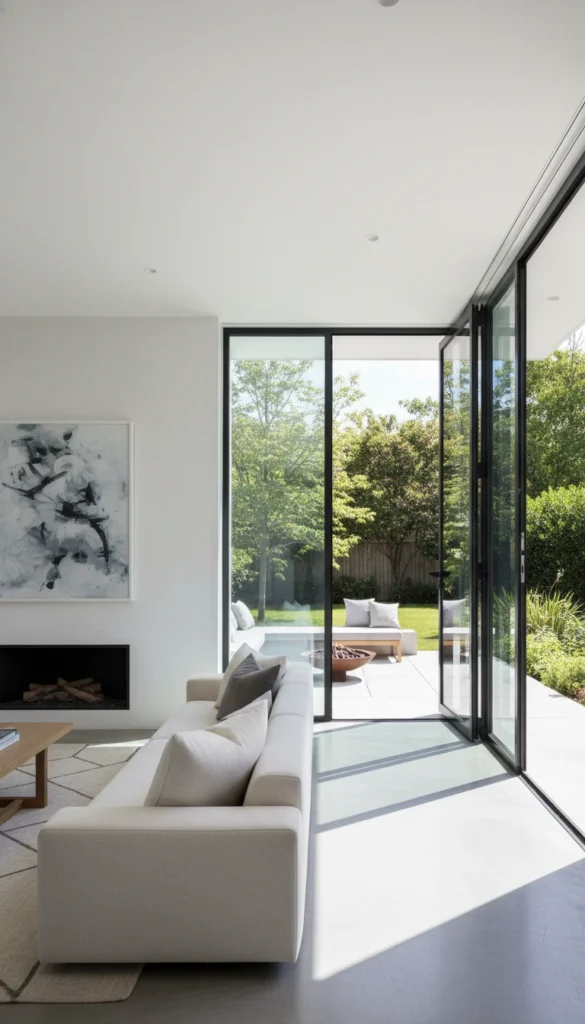
Bi-fold doors give your living room a wonderfully flexible personality. With a quick push, the panels fold back and suddenly the space expands—almost like your home takes a deep breath. I love how these doors let you decide how open or intimate the room feels on any given day.
Here’s why they shine:
• They fold neatly to one side, keeping walkways wide and uncluttered.
• You can partially open them to control airflow and light.
• They’re perfect for living rooms that double as entertaining spaces.
• The large glass panels maintain a bright, airy atmosphere even when closed.
• They work beautifully as room dividers or indoor–outdoor connectors.
9. Mixed Material Partitions (Glass + Wood or Metal)
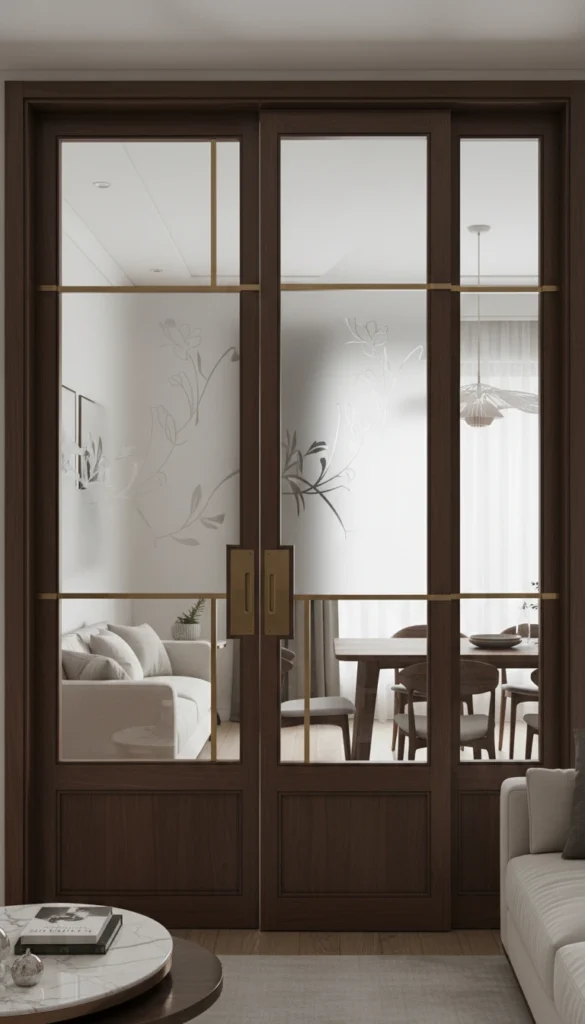
Mixed material partitions strike that lovely balance between structure and softness. Pairing glass with wood—or even a touch of metal—creates a layered look that feels intentional and beautifully detailed. I’ve always found these designs charming because they bring warmth and polish into the same frame, almost like the architectural equivalent of a well-balanced meal.
Why it works:
• Wood adds richness and warmth that plain glass can’t achieve.
• Metal trims or accents sharpen the lines and add a subtle luxe feel.
• Frosted or etched glass softens the view while keeping the space bright.
• You can mix transparency levels to fine-tune privacy.
• The combination feels custom and sophisticated, even in small spaces.
10. Sliding Shoji-Style or Rice Paper-Inspired Doors
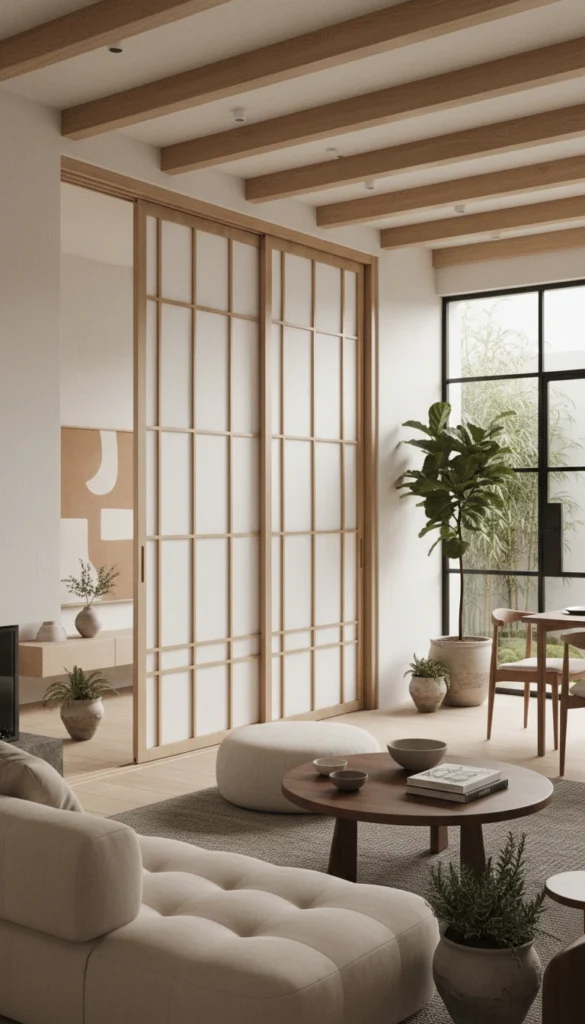
Shoji-style doors bring an immediate sense of calm to a living room. Their soft diffused light, delicate grid patterns, and gentle movement feel almost meditative. Modern versions use durable materials like frosted glass or acrylic, so you get the classic look without worrying about fragile paper panels. Whenever I see these doors, I feel as if the entire room exhales a little.
Pro tips:
• Use light wood tones to keep the look warm and natural.
• Choose frosted or fabric-backed panels for better durability.
• Pair them with neutral textiles to enhance the quiet, serene vibe.
• They work wonderfully in Japandi, minimalist, or Scandinavian-inspired spaces.
• Keep nearby décor simple so the grid pattern can shine.
11. Partial-Height Door Partitions for Zoned Spaces

Partial-height partitions create separation without shutting your living room off from the rest of the home. They strike that sweet spot where you still get airflow, brightness, and long sightlines, but with enough definition to make each zone feel intentional. I’ve always liked how these half-height dividers add structure without the commitment of a full wall.
Why it works:
• The open upper portion keeps the room bright and visually connected.
• The lower solid or semi-solid section grounds the layout and adds privacy.
• Perfect for apartments or open-plan homes that need subtle zoning.
• Works nicely with framed glass, fluted panels, or even mixed materials.
• You gain separation without feeling boxed in—ideal for compact spaces.
12. Curved Door Partitions for Soft, Organic Flow
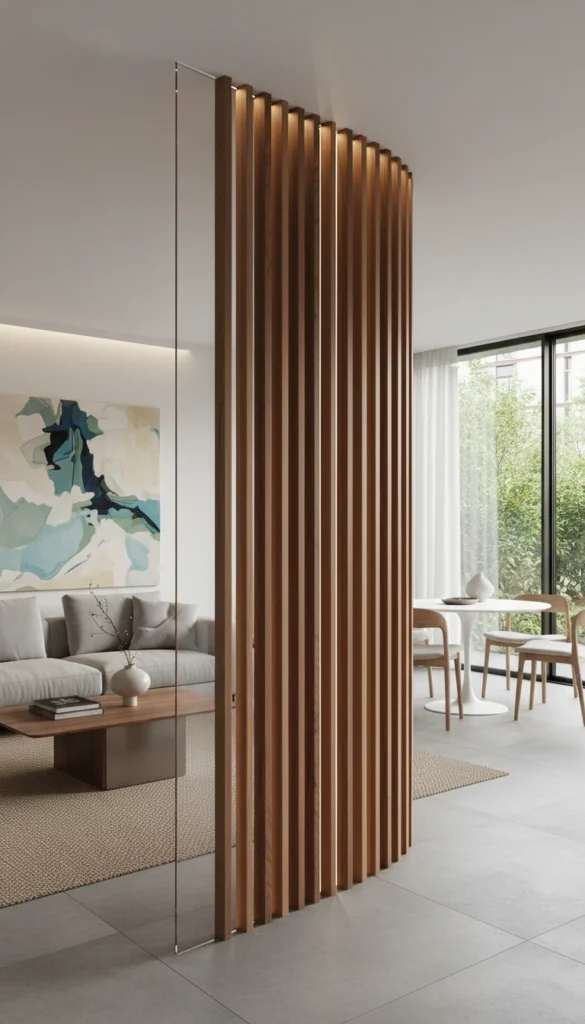
A curved door partition instantly elevates a living room. Instead of slicing a space with a straight line, it guides movement gently and adds a sculptural moment that feels custom-made. I always find curved partitions irresistible—there’s something quietly luxurious about a shape that bends instead of insists.
What makes it special:
• The curve softens boxy, modern layouts.
• Wood tones bring warmth while glass keeps things airy.
• Ideal for corner zones, reading nooks, or mini home offices.
• Adds architectural interest without feeling flashy.
• Works beautifully in minimalist or organic-modern spaces.
How to Choose the Right Door Partition for Your Living Room
Choosing the right modern door partition starts with understanding how you actually use your living room. Do you want privacy, or do you just need a gentle visual separation? Do you need light control, noise reduction, or simply a more flexible layout? Asking yourself a few honest questions makes the decision surprisingly easy.
Think about how your living room connects to the rest of your home. If it sits between busy zones—like a kitchen or hallway—you may value something that softens noise or keeps the area feeling calm. Frosted glass, fluted panels, or mixed-material doors all help create that sense of retreat without blocking out natural light. If your living room doubles as a workspace (which happens more often than any of us admit), a solid or semi-opaque partition can make the space feel more focused.
Size also plays a huge role. Larger rooms can handle bold features like pivot doors or curved partitions without feeling overwhelmed. Smaller spaces often benefit from sliding systems or frameless glass because they divide the room without visually shrinking it. And if your home doesn’t get much sunlight, clear or lightly tinted glass keeps things bright while still defining zones.
Your style preferences matter just as much as practical needs. Warm wood creates a cozy, grounded feeling; metal frames bring clean, modern lines; and traditional Shoji-style panels add softness and rhythm. If you’re unsure, pay attention to your existing furniture and finishes—your partition should feel like a natural extension, not an interruption.
Finally, be honest about maintenance and lifestyle. If kids or pets zoom through your living room like it’s a racetrack, you’ll want materials that hold up well and hardware that’s sturdy. And if you tend to rearrange your layout often (some of us can’t help it), a flexible system like bi-fold or sliding doors gives you options without locking you into one arrangement.
Choosing the right partition isn’t about guessing what “should” work—it’s about finding the balance that matches your habits, your layout, and the feeling you want the room to have.
Practical Tips for Planning and Installing Door Partitions
Planning a door partition might feel overwhelming at first, but the process becomes much smoother when you break it down into simple steps. Start with accurate measurements—width, height, floor levelness, and ceiling type all affect what systems you can use. A small slope in the ceiling can change how a door hangs, so checking early saves headaches later.
Look at furniture placement as well. Doors need space to slide, fold, or pivot, and sometimes even moving a sofa six inches can open up better design options. It helps to sketch out how the door moves so nothing bumps into it.
Hardware matters more than people expect. High-quality tracks, hinges, or pivot systems make the difference between a door that glides effortlessly and one that sticks, rattles, or feels heavy. If the partition is tall or made from heavier materials like metal or solid wood, choosing professional-grade hardware becomes even more important.
As for installation, some styles are DIY-friendly, like simple sliding tracks or lightweight panels. Others—especially pivot systems, curved frames, and anything involving built-in lighting—are better left to professionals. A good rule of thumb: if it involves structural alignment or electrical work, call someone who does it for a living.
Finally, think about long-term use. Soft-close tracks can prevent slamming, and smooth finishes are easier to clean if you have little fingerprints or pet noses pressed against the glass. A bit of planning upfront makes the entire setup more enjoyable long after the installation dust settles.
Conclusion
Modern door partitions do more than divide a room—they shape the way you live in it. Whether you prefer airy glass panels, warm wood details, or bold metal frames, the right partition gives you control over light, flow, privacy, and ambiance. It’s one of those upgrades that feels small on paper but makes a surprisingly big difference once it’s in place.
If you’re unsure where to begin, start with one simple question: How do I want this room to feel? Your answer will point you toward the materials, styles, and features that truly fit your home. And as you experiment, remember that partitions don’t just separate spaces—they help each space shine in its own way.
When you’re ready, the perfect living room layout is just a door (or twelve ideas) away.
